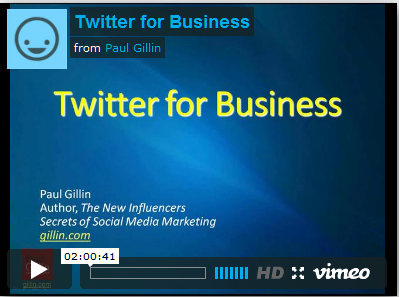Let Your People Speak!
Earlier this week I wrote an article for SocialMediaB2B.com that made the case that last week’s IBM Watson Jeopardy challenge, in which an IBM computer thrashed the two greatest Jeopardy champions of all time, was the greatest B2B marketing campaign ever.
One reason I liked it so much is that IBM let scientists – instead of corporate suits – tell the story of their achievement. This was documented in more than 30 videos that IBM posted on YouTube as well as chat sessions and group Q&A interviews on the website reddit.com.
If you want to see the passion that the IBM scientists brought to this project, watch the 11-minute summary video that was posted shortly after the contest ended. It’s clear that Watson’s accomplishments were more than just a technology triumph. Researchers reacted as if their child had just graduated from Harvard. Their passion was contagious and genuine.
Why don’t more companies let the people who build and support their products come out of the shadows the way IBM did? In part, I believe it’s fear that people will do the wrong thing. It also reflects the time limitations that developers and engineers themselves often cite as a reason to stay in the shadows. Let’s look at each in order.
Tell Stories
Effective communications is about storytelling. Ronald Reagan taught us that. People don’t respond to statistics, feature charts and positioning statements the same way they do to other people. Entrepreneurs excite us when they share their vision, yet successful companies bury enthusiasm under layers of approvals and official spokespeople.
 B2B customers have intense information needs, and their questions are often best answered by the people who build and service the products they use. Some companies understand this. One of my favorite stories from Social Marketing to the Business Customer is Indium Corp., which built a constellation of search-optimized blogs that put their engineers directly in touch with the people who buy their highly specialized products. Result: 600% jump in leads in six months. Marcom Director Rick Short (left) says his job is to “get engineers talking to customers and then get out of the way.”
B2B customers have intense information needs, and their questions are often best answered by the people who build and service the products they use. Some companies understand this. One of my favorite stories from Social Marketing to the Business Customer is Indium Corp., which built a constellation of search-optimized blogs that put their engineers directly in touch with the people who buy their highly specialized products. Result: 600% jump in leads in six months. Marcom Director Rick Short (left) says his job is to “get engineers talking to customers and then get out of the way.”
Do unofficial spokesmen sometimes say the wrong thing? Sure. Does it matter? Not really. Corporations are far too sensitive to the indiscretions of individuals, which usually can be sidestepped with an apology or explanation. A couple of hours of media training does wonders.
Blogs Are the New Trade Show
The issue of time commitments and availability is valid, but usually overstated. Many engineers are only too happy to write papers and travel thousands of miles to deliver presentations, yet writing a 500-word blog entry or recording a how-to video is seen as overwhelming.
There’s a contradiction here. Engineers naturally like to share, and they know that conference presentations are good for their careers. Contributions to the company’s social media programs potentially reach a much larger audience than a presentation at a trade show. They go to the trade show because that’s what’s always been done.
I wish more corporate marketers would adopt Rick Short’s philosophy and see themselves as facilitators rather than spokesman. They should be the ones urging recalcitrant executives to draw contributors out from behind the curtain. They should have the statistics to demonstrate that the blog reaches a larger audience than the trade show. They should be the ones positioning customer communications as a privilege, not a chore.
The best way to encourage individual contributors to participate in your social media programs is to celebrate them. That doesn’t have to cost a lot of money. Recognize contributions to the corporate blog in your employee newsletter, or hand out awards for the most prolific or creative contributors every quarter along with a small gift certificate. When people see that their involvement is good for their careers, they quickly come on board.
Lots to Tell About B2B Social Marketing
When you have a book to promote, you somehow manage to be everywhere at once! Eric and I have had a great time these last few weeks evangelizing the idea that business-to-business markets really are different from B2C markets and deserve their own tactics and tools.
- We spent an hour with Shel Holtz, Neville Hobson and a very active online discussion community this past Saturday talking about some of our favorite examples of social media B2B excellence. If you don’t already subscribe to Shel and Neville’s excellent For Immediate Release podcast, I highly recommend it.
- We also had a great interview with Mitch Joel, author of Six Pixels of Separation. Mitch sees things today that only become evident to the rest of us years from now. The guy is scary smart.
- Eric Lundquist was my arch rival when I was an editor. Now we’re just two guys trying to figure out where media is going. We Skyped just yesterday for Eric’s CIO Insight show. Pulse Network puts on a very professional production.
- I contributed an article to Multichannel Merchant about How to sell social media marketing to skeptics.
- I also wrote up a great case study about how electronics distributor Element14 is using “modding” videos to attract engineers. What’s modding? Read the article and find out!
- Eric and I posted the third episode of our B2B Social Media Podcast. Don’t ask me where the photo came from.
Tip of the Week: Free Twitter Seminar
Last week I presented a two-hour webinar for Alpha Software on how to use Twitter for business. Alpha gave me the video feed for the whole program, so I thought why not share? So if you go to the presentations page on my website, you’ll find it at the top. All two hours’ worth. Judging by the number of people who stayed online for the whole talk, it must be somewhat useful. There are a lot of other presentations on that page that you can also view and download.

Just for Fun: Atlas Obscura
In a town called Lluvia de Peces in Honduras, an amazing thing happens once or twice a year. A large storm rolls through with heavy rain and after it’s gone, the the streets are full of flopping live fish.
At the Dittrick Museum of Medical History at Case Western Reserve University you can find the largest collection of historical contraceptives in the world, more than 1,000 items.
In southern Arkansas, they’re still trying to figure out the mystery of the Gurdon Light (below), an eerie white-blue, sometimes orange, glowing orb that moves through the trees. Some say it’s the lantern of a railroad worker who fell on the tracks and was beheaded.
These and thousands of other odd, obscure and wondrous places around the world are documented on Atlas Obscura, a travel wiki of breathtaking scope. Want to visit the geographical center of the lower 48 states? It’s two miles northwest of Lebanon, Kansas. A small stone pyramid marks the point. That’s one of 150 listings in the category of “Geological Oddities.” Altogether, I estimate Atlas Obscura has nearly 4,000 entries, many with a considerable amount of background information. It’s impressive, absorbing and often pretty weird.



 She would do no such thing. CareOne actually takes a disciplined approach to figuring ROI, she said, using control groups and thousands of data points. Not only do community members convert at dramatically higher rates, but the boost in sign-ups is only one of several business benefits CareOne has realized from its customer community. But more on that in a minute.
She would do no such thing. CareOne actually takes a disciplined approach to figuring ROI, she said, using control groups and thousands of data points. Not only do community members convert at dramatically higher rates, but the boost in sign-ups is only one of several business benefits CareOne has realized from its customer community. But more on that in a minute. CareOne is focusing on the right stuff. The section headlined “CareOne + Social Media: The Measurement” on the
CareOne is focusing on the right stuff. The section headlined “CareOne + Social Media: The Measurement” on the 
 With Nimble, you can import your address book, Facebook and LinkedIn contacts into a single record and associate people’s activities in those networks – as well as Twitter and your inbox – in a single place. So if you’re making a call on a prospect or customer, you can quickly consult the personal or company record to find out what’s been happening in their lives or careers.
With Nimble, you can import your address book, Facebook and LinkedIn contacts into a single record and associate people’s activities in those networks – as well as Twitter and your inbox – in a single place. So if you’re making a call on a prospect or customer, you can quickly consult the personal or company record to find out what’s been happening in their lives or careers.